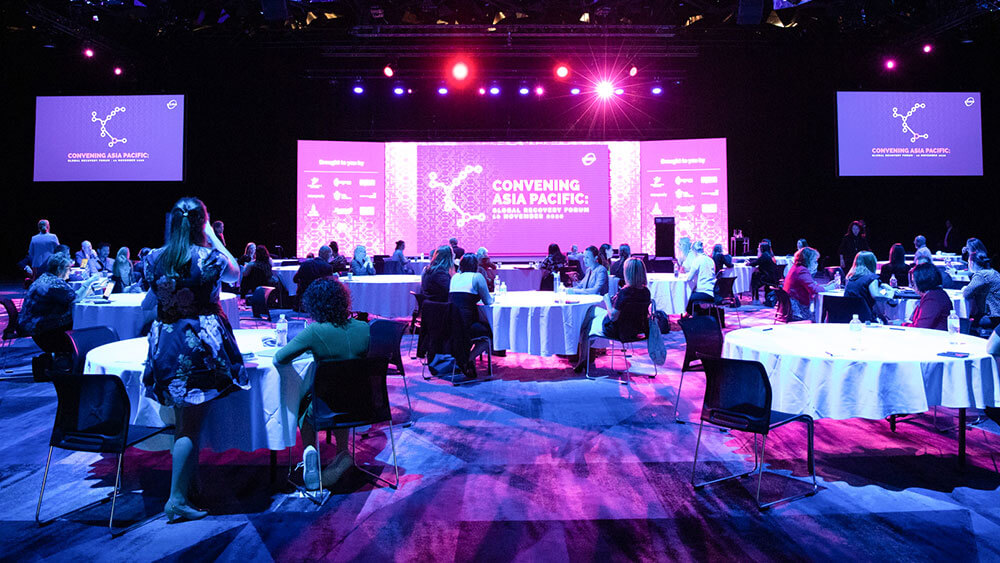
PCMA’s hybrid event, Convening Asia Pacific: Global Recovery Forum, took place physically in Sydney, Australia, and digitally around the world.
While hybrid events are nothing new, the focus during COVID times has been flipped: Much more emphasis is now placed on designing a holistic experience from a digital perspective vs. designing an in-person experience with a digital component.
Such is the case with PCMA’s Convening Asia Pacific: Global Recovery Forum, held Nov. 10 in Sydney, Australia, and online around the world. Digital participants engaged in content created just for them, including the intro session, “Together Apart: Engaging Your Audience With Digital Events,” presented by digital event strategists Sourabh Kothari and Jennifer Kingen Kush, Kingen Kush Solutions.
Convene spoke with Kothari — CEO of Mindcurrent, a startup that uses AI to predict behavioral, biometric, and stress patterns, who has been serving as a digital events consultant for PCMA — about takeaways from the session and the event itself.
‘Embracing a Hybrid Design From the Get-Go’
Convening Asia Pacific was based in Sydney “for a lot of the right reasons,” Kothari said, including the fact that the city has successfully quashed the virus. (On Nov. 10, Sydney had only 10 new reported cases of COVID-19.) Even so, any speakers outside of the country would have had to quarantine for 14 days before attending the event in person. “So, if you’re going to be in your hotel room,” for that period of time, Kothari said, “why wouldn’t you just present from home? In this situation, you could only source physical participants and speakers in Sydney. It was even hard to get people to travel across Australia to come to the event. Yet the topics were attractive to so many people in Asia Pac and speakers, really good ones, were located outside of Sydney. So, the first piece was really embracing a hybrid design from the get-go, because even some of your best speakers would not have been able to go to the physical location.”
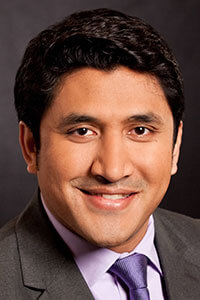
Sourabh Kothari
The attendees who arrived in person at ICC Sydney were chatting with the online audience, Kothari said, posting messages like, “’Hello everybody on the virtual. I’m here in Sydney — I’m actually here in person. I don’t remember the last time I did this.’ There was a lot of excitement, and from what we could tell from the video that we saw of the attendees and especially during the keynotes, people were very focused, most people were smiling — they were clearly happy to be together at an event, even though the social distancing was in play.”
Kothari thinks level of enjoyment was directly related to the short duration of the event. “It was a few hours, and it was over.” In addition to managing the duration and having a “small number of participants” it was made very clear that risky behavior would not be tolerated, he said.
A key part of the overall event design was launching with the first session solely for the digital audience, Kothari said, instead of merely streaming the keynote or the welcome. “We opened as virtual presenters to the virtual audience before people saw the welcome address and the keynote at the actual location,” he said. “The in-person attendees were coming in, registering, and settling in during this session for the online audience only — they’re your primary audience. If you think about it, the reach, the impact, the conversations, the relationships were built much more significantly on the virtual attendees than the 100 or so people that showed up in Sydney. There’s a lot more exposure through the virtual reach.”
The design of the event, Kothari added, “was inversed. It was virtual first with a solid in-person experience for a limited number of speakers and a limited number of attendees with social distancing in place.”
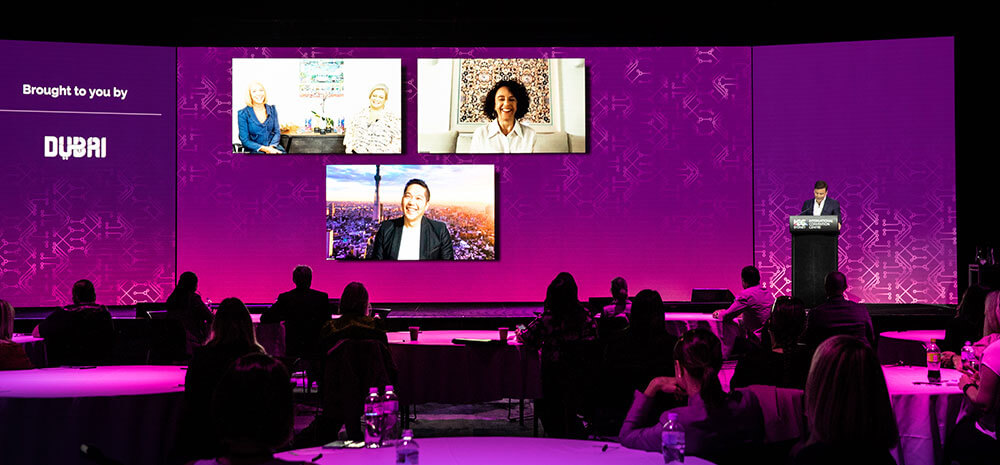
Any speakers traveling to Sydney would have had to quarantine for 14 days before attending Convening Asia Pacific in person, making the hybrid format the smartest choice.
How Many to Expect?
As is the case with digital events, the PCMA team really didn’t know whether to expect 250 or 2,500 virtual attendees, Kothari said. “There was no precedent. This is the first event of this kind in Asia Pacific that the PCMA team has done. It’s an experiment for the brand in that region,” he said. “Maybe people who said they’d show up would show up. The price was very reasonable, so it wasn’t like we had to lock them in early and work them to get them to buy.”
There also was no sense of how many would go to the breakout sessions. “This was really challenging from a design perspective,” Kothari said. “How do you pick a platform that has that rich experience, but yet your cost per attendee is reasonable?” Selecting Bizzabo, he said, provided a platform with “a really good experience which could be driven by a few people who were engaged but it could also handle a lot of engagement if more folks showed up. And both happened.” More than 500 virtual attendees logged in to the program.
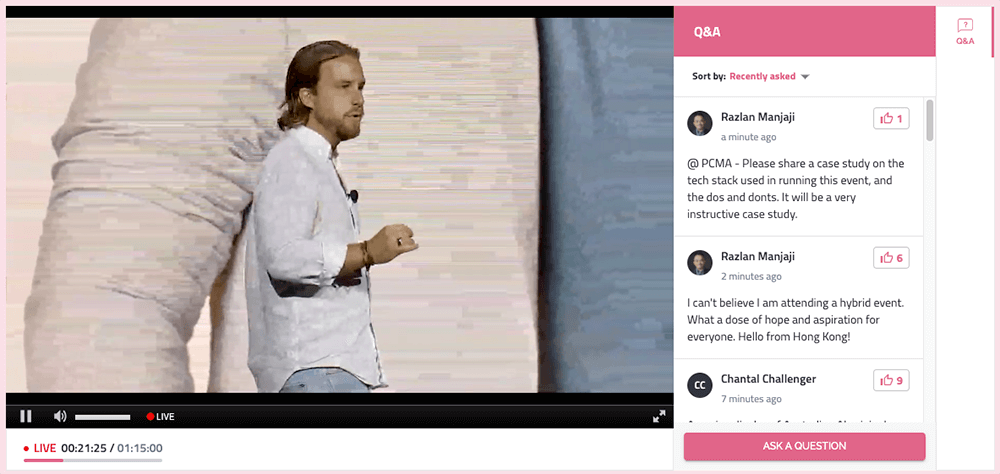
Jack Delosa presents his live session, which was streamed to virtual attendees. Chat messages in the digital environment allowed attendees to communicate with each other and sometimes with the speakers.
Browser Issue
As the “event before the event,” Kothari said that his session was the “guinea pig” for what was to follow, and sure enough, there was one initial tech hiccup. Bizzabo “is very user friendly. It takes very few clicks to do things, but it’s optimized for Chrome, not Safari,” he said. “So you’ve got two things happening now, and this is very interesting because it’s happening in Asia — and the concept of saving face was very evident in the first few minutes because as people started to report in, ‘I’m having a problem connecting,’ traditionally, you don’t highlight that in Asia.”
The first inclination was to respond individually to those who said they were having technical issues in the first few minutes and take the comments out of chat so it didn’t take focus away from those participating in the session. But as more chimed in saying they couldn’t see the session, the team was able to quickly troubleshoot: Only those using Safari were having a problem accessing the session, so that was posted in the chat box.
“I think this is a matter of platforms doing their testing, being confident across all browsers, and making updates as frequently as they can because of demand, but I would say that Safari is definitely the red-headed stepchild because it’s not the default browser for most things,” Kothari said. “Generally, the only time people use Safari is on their iPhones because they forgot to switch it. The team wasn’t expecting so many people to show up on Safari because we thought they’d be on their laptops and desktops, and so they’d be on Chrome. That was a lesson, but again, you roll with it. By the first session, we had the Safari issue resolved.”
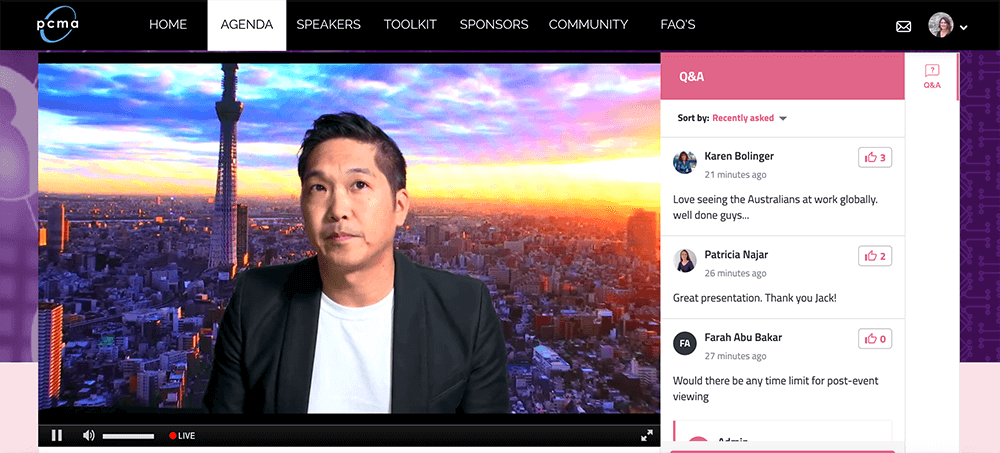
Benson Looi, managing director and technical producer at Utopian, presented on engaging virtual audiences in a virtual environment.
Let Us See You
Because of the ease of use of the platform, Kothari said, “we were able to — and I think this is loads of fun — have attendees identify themselves and say, ‘I would like to ask my question in person,’ as in, ‘Will you switch on my video and audio, please?’”
While the bulk of Q&As for Kothari and Kingen Kush’s session came via text, participants were encouraged to open their audio and webcam so they could be seen and heard by other participants. “And finally, after a bunch of questions via text, two people raised their hands. One of them couldn’t get it to work because their webcam wasn’t cooperating, but the second person came on, and this is in the last few minutes of the session, you could feel the other attendees come to life when they saw one of their own asking her question, and she got promoted, so to speak, because messages came in from other attendees of like, ‘Woo hoo! Well done,’ and, ‘It’s so nice to see you,’ you know? You don’t know what to expect, and there is the precedence in Asia Pac that folks will not want to interrupt the speaker or ask a ‘dumb question,’” Kothari said, so this interaction was an unexpected and welcome development.
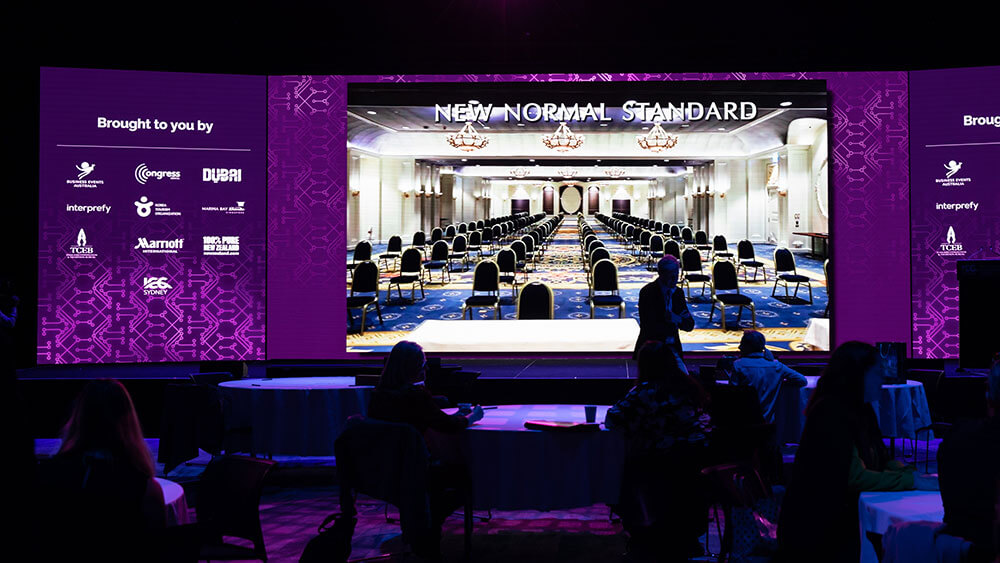
The new normal includes rooms set up for social distancing at physical events, and working at whatever time makes sense for digital events.
‘Giving Attendees a Voice Instead of Just a Vote’
It’s customary at events for presenters to ask questions and participants can respond via a poll — “you can get all the data and it’s neat, and then you can have it to report later,” Kothari said. “My issue with polls is that nobody knows what anybody else said because they’re designed that way, and they can only give me the answer from the options that I gave them.” While Kothari did use the polling feature, he also gave participants the option to respond to questions in chat.
For example, Kothari said, before the end of his session’s Q&A portion, “I asked: ‘So folks, you’re wondering about how you’ll introduce hybrid in Asia Pac, what are the first things to do, what are the things to look out for? For your next event, are you planning a hybrid event or are you planning a virtual only? And now throw in your responses, or vote.’”
When you ask people to respond via chat, everybody’s response comes in with their name, he said. “Immediately, the attendees become aware of who is doing what. And what happens is people then want to connect with other people who are doing what they’re doing, and some people put in answers that have a little bit more color, like, ‘We’re doing virtual now, but hopefully hybrid by the end of the 2021,’ and someone else responds to that, ‘We are also hoping we’ll do hybrid.’ And it starts a dialogue.”
Even though those conversations are “messier” than a straightforward poll, Kothari said, “the difference is you’re giving your attendees a voice instead of just a vote.”
This approach requires that speakers are able to “manage the focus and attention and intent of your audience,” he said. “If they don’t know how to do that, if they don’t know how to wrangle cats in real time and have people lean in instead of be defiant or defensive, then this isn’t something that you should do.”
Chat messages come in fast and start disappearing as more comments come into the chat window. But Kothari said that you can scroll down and pick a comment and call that out. “We did that twice, and the second time you do it, the response is even greater than the first because now everyone has seen the value of responding.”
The second question Kothari asked the group was about the timing of their next planned event. “And there were many, many colorful answers there, and also some insightful ones,” he said, with people adding details about their events and concerns — “I would’ve never gotten any of that on a poll.”
Kothari said that “as we warmed the chat up and we got people chatting with each other,” people started to say where they were from — including Europe, South America, and North America. “I think that was an eye opener,” he said. “We’d say, ‘Wait. Isn’t it 1:30 in the morning for you?’ And they’re like, ‘Yeah, and I’m loving it.’ It’s like, oh my gosh. This is the new reality during COVID. We work on whatever time we want.”
Michelle Russell is editor in chief of Convene.
